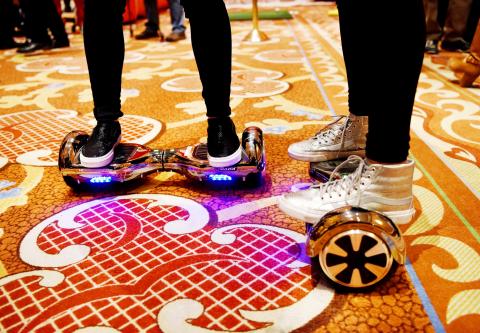Shortly before Christmas, with sales of hoverboards surging as the must-have gadget, Shane Chen flew to China to confront his tormentors.
Chen is the man who developed and patented the hoverboard design in his lab on the US west coast four years ago. With its two wheels, the “hoverboard” doesn’t quite match up to the promise of its namesake in Back to the Future — but that has not put a dent in its popularity.
Hundreds of thousands of hoverboards have been flying off shelves; celebrities have posted videos of themselves riding — and falling — off them. Even a Filipino priest got in on the act — and was promptly suspended for riding one during Christmas Eve mass.

Photo: David Paul Morris, Bloomberg
Someone was making lots of money, but it wasn’t Chen. He marketed his design under the brand name Hovertrax, which sold for about US$1,000. Cheap imitations, made in Chinese factories, have flooded the market at about one quarter of the cost.
“We only made maybe a few thousand,” Chen said. “I got a report that there are over 11,000 factories making them in China. They made more than a million.”
Last month, Chen went to China to see for himself. “I visited some of the knockoff factories. They actually thanked me for having the imagination to invent it. They understand they’ve infringed my patent but they know there’s nothing I can do,” he said.
So he hasn’t gotten rich off his invention?
“No, no,” he sighed. “If you look at history, inventors are usually poor. Other people make money. By the time we did the Hovertrax I was kind of used to it because there are about six of my inventions that have been copied over the past 10 years.”
The offices of his company, Inventist, in the small town of Camas, Washington, are littered with the carcasses of failed inventions that demonstrate Chen’s taste for trying to get people on the move. They include prototypes for various kinds of water craft, bicycles with odd limbs welded on, a cluster of cannibalized scooters and a device resembling a small World War I tank.
“It’s designed to pull skiers uphill. They stick it in a backpack when they ski back down. It works but I was never happy with it so I never put it on to the market,” he said.
“I’m constantly inventing things. There are usually five or six different things I’m working on. Most of them fail but I’m getting better. In an earlier time, one in a hundred worked. Now maybe one in five or 10.”
Among those that have paid off is a human-powered hydrofoil, the AquaSkipper, which made enough to fund other projects. He also made money from a scooter called the Powerwing and his first marketed invention, an exercise device, the Bodytoner. But there’s been nothing like the hoverboard — and there nearly wasn’t.
It has its roots in the invention of which Chen is much prouder, and which he uses day to day — a motorised single wheel with foot plates on either side, the Solowheel. The rider stands upright without anything to hold or sit on — what you might get if a unicycle bred with a Segway. At 25.7kph, it goes twice as fast as a hoverboard and is more practical for getting around the streets because of its larger wheel fitted with a bicycle-style tire.
The problem, Chen said, is that people take one look and can’t imagine how they stay on. At one point his daughter was demonstrating it at a trade show when she put one on each foot. “Then she could spin, stand still, go backwards,” he said. The idea for the hoverboard was born. He took the two wheels and joined them with a board. The design was modified through various prototypes, shrinking the wheels and moving them into the board.
Interest was scant at first. “We were riding around on it and no one cared,” he said. He improved the design and took it to other trade shows but it was not until last year that the hoverboard took off.
“It has to be around long enough that everyone wants one. I saw a story that when Thomas Edison invented the lightbulb nobody wanted it. They were telling him that the flame in the lamp was better. You can see the problem,” he said.
Chen was not even that enthusiastic himself. He still regarded the Solowheel as the better invention. “Hovertrax to me is just a toy. A toy for kids, for adults. It’s fun. But you cannot use it for transportation. It’s not practical,” he said.
But once interest took hold, he lost control. “When you have a product that sells a few, you can easily stop the knockoffs. When the product becomes too valuable, there’s nothing you can do,” he said. “It’s like a tsunami. Legal or illegal, they’re just going to do it. It’s like drugs, marijuana.”
Still, it grates with Chen that big supermarkets and department stores facilitate the counterfeiters by dealing in knockoffs. “It is very discouraging. The patent system is not working if something is popular. With something like Hovertrax, the patent is almost useless.”
Chen acknowledges that the problem is the price. He has put out a cheaper version that is nearly half the cost of the original but he said there is only so far he can go. The counterfeits save production costs with weaker motors and low-quality batteries, but that leaves them underpowered and unstable, making riders more likely to fall. They are also more likely to catch fire, which is why some airlines have banned them.
“We explain to consumers, this has to be built safely. It cannot be that cheap. They don’t care. They want it and they want cheap ones,” he said.
All of this is all the more frustrating because Chen left China nearly three decades ago to get away from a system he regarded as too restrictive before the free-for-all. He worked for many years in a Chinese government job designing scientific instruments but wanted to found his own company and decided the US was the place to do it. He moved in 1986, established a scientific instrument design business but sold that five years ago to get on with what really interested him: inventing things.
Chen hasn’t given up on Hovertrax. But what interests him is the next big thing. He holds up a plastic jumble that looks as if it might be a salad washer. It turns out to be a battery-operated water jet for a one person hydrofoil. “You fly along the water with very little drag. You use very little energy. I think this will replace the jet ski. The jet ski is noisy and dangerous. This is very quiet,” he said. But it’s wheels that really excite him.
“This is the best of all my inventions,” he said, pushing forward a box marked Lunicycle. It’s another single wheel but with pedals. A unicycle without the pole or the saddle.” You pedal standing up. The unicycle is very hard to learn. It takes about six months. People can learn this in half an hour. We just started selling them. We don’t know how to market it, how to tell people, because people think that it’s a unicycle,” he said, sounding genuinely baffled at the confusion.

June 2 to June 8 Taiwan’s woodcutters believe that if they see even one speck of red in their cooked rice, no matter how small, an accident is going to happen. Peng Chin-tian (彭錦田) swears that this has proven to be true at every stop during his decades-long career in the logging industry. Along with mining, timber harvesting was once considered the most dangerous profession in Taiwan. Not only were mishaps common during all stages of processing, it was difficult to transport the injured to get medical treatment. Many died during the arduous journey. Peng recounts some of his accidents in

“Why does Taiwan identity decline?”a group of researchers lead by University of Nevada political scientist Austin Wang (王宏恩) asked in a recent paper. After all, it is not difficult to explain the rise in Taiwanese identity after the early 1990s. But no model predicted its decline during the 2016-2018 period, they say. After testing various alternative explanations, Wang et al argue that the fall-off in Taiwanese identity during that period is related to voter hedging based on the performance of the Democratic Progressive Party (DPP). Since the DPP is perceived as the guardian of Taiwan identity, when it performs well,

The Taiwan People’s Party (TPP) on May 18 held a rally in Taichung to mark the anniversary of President William Lai’s (賴清德) inauguration on May 20. The title of the rally could be loosely translated to “May 18 recall fraudulent goods” (518退貨ㄌㄨㄚˋ!). Unlike in English, where the terms are the same, “recall” (退貨) in this context refers to product recalls due to damaged, defective or fraudulent merchandise, not the political recalls (罷免) currently dominating the headlines. I attended the rally to determine if the impression was correct that the TPP under party Chairman Huang Kuo-Chang (黃國昌) had little of a

At Computex 2025, Nvidia CEO Jensen Huang (黃仁勳) urged the government to subsidize AI. “All schools in Taiwan must integrate AI into their curricula,” he declared. A few months earlier, he said, “If I were a student today, I’d immediately start using tools like ChatGPT, Gemini Pro and Grok to learn, write and accelerate my thinking.” Huang sees the AI-bullet train leaving the station. And as one of its drivers, he’s worried about youth not getting on board — bad for their careers, and bad for his workforce. As a semiconductor supply-chain powerhouse and AI hub wannabe, Taiwan is seeing